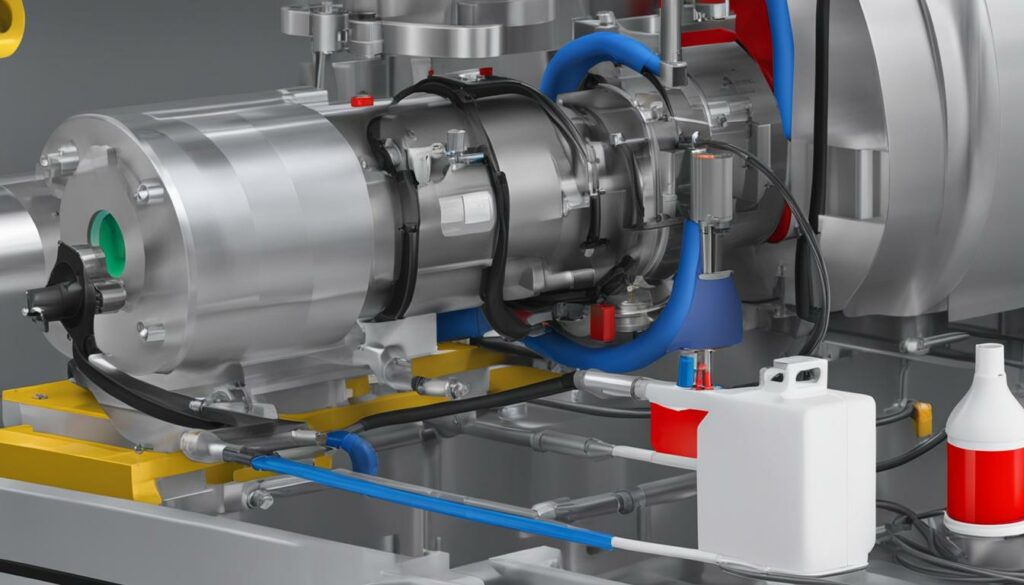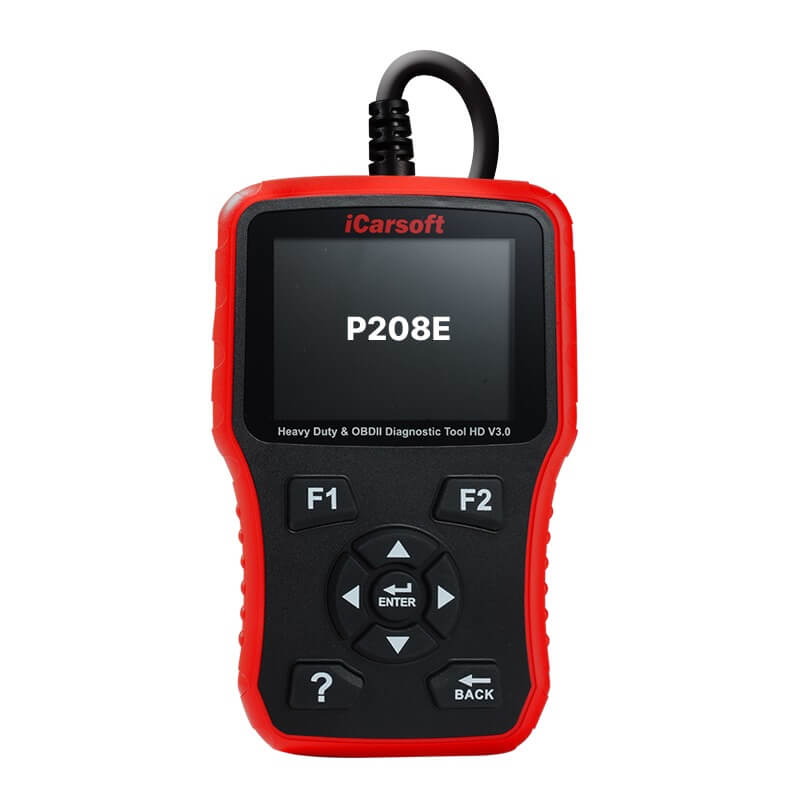P208E – Reductant Pressure Too Low For Normal Operation
POSTED IN pcodes
Welcome to our article on the P208E trouble code, also known as Reductant Pressure Too Low for Normal Operation. If you’ve encountered this code, it indicates a problem with the reductant pressure in your vehicle’s urea injection system. Understanding the causes and symptoms of this issue is crucial for proper diagnosis and repair.
When your vehicle’s engine control module detects that the reductant pressure is outside the manufacturer-set parameters, it will trigger the P208E fault code and illuminate the check engine light. This code is applicable to vehicles equipped with OBD-II systems, which are commonly found in modern vehicles.
Diagnosing and addressing the P208E code is essential to maintain the proper operation of your vehicle’s emission control system. This article will provide you with detailed information about the code, its potential causes, common symptoms, and repair solutions. By understanding the problem, you can take the necessary steps to ensure your vehicle remains in optimal condition.
Key Takeaways:
- The P208E code indicates a variation in the reductant pressure of your vehicle’s urea injection system.
- When the reductant pressure is too low, the engine control module stores the P208E fault code and illuminates the check engine light.
- Common symptoms of the P208E code include the check engine light being illuminated.
- Potential causes of the P208E code include a faulty reductant pump, malfunctioning reductant injector, or issues with the reductant pressure line.
- Repairing the P208E code involves identifying and replacing the faulty components, following the manufacturer’s guidelines.
Understanding P208E – Reductant Pressure Too Low For Normal Operation
The P208E code indicates a problem with the reductant pressure in the vehicle’s urea injection system. The engine control module monitors this circuit and if the pressure is too low, it will store the code and turn on the check engine light. This code is considered a generic powertrain code, meaning it applies to vehicles equipped with OBD-II systems. The specific repair steps for addressing P208E may vary depending on the vehicle make and model.
The P208E code is a crucial indicator of a reductant pressure issue in the vehicle’s urea injection system. When the pressure falls below the normal range, it triggers the engine control module to store the code and illuminate the check engine light. As a generic powertrain code, P208E is applicable to vehicles equipped with OBD-II systems. However, it’s important to note that the repair procedures for resolving this issue may differ based on the specific make and model of the vehicle.
Buy tested tuning file for Adblue / EGR / DPF / Adblue off now!
Register Now or Already have an account, Login now
To effectively address the P208E code and rectify the reductant pressure problem, it is necessary to have a comprehensive understanding of the urea injection system and the engine control module’s functions. By accurately diagnosing the underlying cause of the low reductant pressure, appropriate repair steps can be taken to restore the system’s functionality.
The reductant pressure plays a critical role in ensuring optimal operation of the urea injection system, which is responsible for reducing harmful emissions and complying with environmental regulations. When the reductant pressure is too low, it can lead to inefficient performance and potential damage to the emission control system.
Urea Injection System Overview
The urea injection system is an essential component of modern diesel vehicles equipped with selective catalytic reduction (SCR) technology. Its primary function is to reduce the nitrogen oxide (NOx) emissions generated during the combustion process. This system utilizes a special reductant solution known as Diesel Exhaust Fluid (DEF) or AdBlue®, which is a mixture of urea and deionized water.
When the engine produces exhaust gases containing high levels of NOx, the urea injection system sprays the DEF into the exhaust stream. The high temperature within the exhaust system causes the DEF to decompose into ammonia (NH3), which reacts with the NOx in the catalyst to convert it into harmless nitrogen (N2) and water (H2O).
The reductant pressure is critical for ensuring the proper injection and distribution of DEF in the exhaust system. If the pressure drops below the manufacturer’s specified range, it can lead to insufficient DEF delivery, resulting in increased NOx emissions and potential damage to the catalytic converter.
To diagnose the specific cause of the P208E code accurately, a comprehensive inspection of the urea injection system components and related circuits is necessary. This includes assessing the reductant pump, reductant injector, reductant pressure line, and reductant pressure sensor for any signs of malfunction or failure.
The Engine Control Module’s Role
The engine control module (ECM) plays a crucial role in monitoring and controlling various aspects of the vehicle’s operation, including the urea injection system. It constantly monitors the reductant pressure circuit to ensure it remains within the manufacturer’s specified range for normal operation.
When the ECM detects a reductant pressure that is too low, it stores the P208E fault code and activates the check engine light. This serves as a warning to the driver that there is an issue with the urea injection system and that immediate attention is required.
Additionally, the ECM also has the capability to record freeze frame data, which captures important vehicle parameters at the time of the fault code occurrence. This data can be invaluable for diagnosing and troubleshooting the specific cause of the low reductant pressure.
It is important to consult the vehicle’s service manual or seek professional assistance to accurately interpret and diagnose the freeze frame data associated with the P208E code.

Having a clear understanding of the role of the reductant pressure, urea injection system, and engine control module is crucial for effectively addressing the P208E code and restoring the vehicle’s emission control system to normal operation.
In the next section, we will explore the common symptoms associated with the P208E code and how they can indicate a potential reductant pressure issue in the urea injection system.
Common Symptoms of P208E
When the P208E code is present, some common symptoms may occur, which may help you identify the issue with the reductant pressure in your vehicle’s urea injection system. The primary indicator of this problem is the illumination of the check engine light. However, it’s important to note that other symptoms may also manifest, depending on the specific make and model of your vehicle.
Here are some common symptoms associated with the P208E code:
- Check engine light illuminated: The check engine light is the primary and most noticeable symptom of the P208E code. When this light illuminates, it is crucial to address the issue promptly to prevent potential damage to the vehicle’s emission control system.
- Reduced engine performance: In some cases, you may experience a decrease in engine performance when the P208E code is present. The vehicle may lack power and responsiveness, affecting your overall driving experience.
- Decreased fuel efficiency: Another possible symptom is a reduction in fuel efficiency. Since the reductant pressure is not within the normal parameters, the vehicle may require more fuel to operate efficiently, resulting in decreased mileage.
- Unusual exhaust emissions: The improper reductant pressure can affect the emission control system, resulting in abnormal exhaust emissions. You may notice smoke, unusual odors, or visible pollutants coming from the exhaust pipe.
- Difficulties starting the engine: In some cases, the P208E code can cause difficulties starting the engine. The vehicle may take longer to start, require multiple attempts, or fail to start altogether.
It’s crucial to address these symptoms promptly to avoid further complications and potential damage to your vehicle. If you experience any of these symptoms or have a check engine light illuminated, we recommend seeking professional assistance to diagnose and resolve the underlying issue.
Potential Causes of P208E
When encountering the P208E code, there are several potential causes to consider. These include:
- Faulty Reductant Pump: A malfunctioning reductant pump can lead to inadequate pressure within the urea injection system, triggering the P208E code.
- Malfunctioning Reductant Injector: If the reductant injector is not operating correctly, it may fail to deliver the proper amount of reductant, resulting in low pressure and the P208E code.
- Inoperative Reductant Purge Valve: An inoperative reductant purge valve can restrict the flow of reductant, leading to reduced pressure and the activation of the P208E code.
- Issues with the Reductant Pressure Line: Damage or blockages in the reductant pressure line can impede the proper flow of reductant, resulting in low pressure and the P208E code.
- Unusable Reductant Pressure Sensor: A malfunctioning or unusable reductant pressure sensor may provide inaccurate readings, leading to false detections of low pressure and the activation of the P208E code.
Risk Factors
The risk of encountering the P208E code can vary depending on several factors, including the vehicle’s age, mileage, and maintenance history. Additionally, extreme weather conditions, such as cold temperatures, may put additional strain on the reductant system and increase the likelihood of encountering this issue.
To accurately diagnose the specific cause of the P208E code, it is essential to perform a thorough inspection of the reductant system components. This can involve testing the functionality of the reductant pump, injector, purge valve, pressure line, and pressure sensor. Only by identifying the exact cause can the appropriate repair steps be taken to resolve the issue.
Next, we’ll explore the necessary repair procedures for addressing the P208E code and restoring the reductant pressure to normal levels.
Repairing P208E – Reductant Pressure Too Low
When encountering the P208E code, it is crucial to identify and replace the faulty components in order to rectify the issue. This typically involves replacing the reductant pump, reductant injector, reductant purge valve, reductant pressure line, or reductant pressure sensor. These components play a vital role in maintaining the reductant pressure within the acceptable range for normal operation.
Following the manufacturer’s guidelines and directions is essential during the repair process to ensure proper installation and operation of the components. It is recommended to refer to the vehicle’s specific repair manual to obtain accurate instructions tailored to your make and model.
Addressing the P208E code promptly and effectively is crucial to maintain the optimal performance of your vehicle’s reductant system. By replacing the faulty components, you can restore the reductant pressure to an acceptable level, enabling normal operation and preventing further complications.
Benefits of Proper Repair
Accurately repairing the P208E code offers several advantages:
- Restores reductant pressure within the manufacturer’s specified parameters
- Prevents potential engine performance issues
- Ensures optimum emission control
- Prolongs the lifespan of the reductant system components
By attending to the underlying cause of the P208E code, you can ensure the continued smooth operation and efficiency of your vehicle’s reductant system.
Professional Assistance
If you are uncertain about identifying or replacing the faulty components yourself, it may be beneficial to seek professional assistance. Automotive technicians have the expertise and tools necessary to accurately diagnose and repair the P208E code. Their experience in dealing with reductant systems can help streamline the repair process and ensure optimal results.
Alternative Solution
Alternatively, for those who prefer an alternative solution, it is possible to permanently remove the P208E code by uploading the Engine Control Unit (ECU) file to a specialized portal. This alternative method eliminates the need for component replacement and may be suitable for specific circumstances. However, it is important to weigh the benefits and potential drawbacks of this option before proceeding.
Choosing the appropriate repair method—either component replacement or an alternative solution—depends on factors such as budget, time constraints, and personal preferences. Nevertheless, taking action to address the P208E code promptly is critical to ensure the optimal functioning of your vehicle’s reductant system and maintain compliance with emission standards.
Continue reading to gain a comprehensive understanding of the potential benefits and drawbacks associated with the alternative solution for P208E repair.
Professional Assistance and Alternative Solution
If you find yourself in a situation where professional assistance is unavailable or if you’re looking for an alternative solution, there is an option to permanently remove the P208E code. Through the utilization of an Engine Control Unit (ECU) file, you can have the specific P208E code permanently eradicated from your vehicle’s system.
This alternative solution offers a convenient method to address the P208E code without resorting to traditional repair methods. By uploading your ECU file to a secure portal, you can effectively eliminate the code and restore normal operation to your vehicle.
Eliminating the P208E code through the ECU file allows you to bypass the need for physical repairs and replacement of components related to reductant pressure. This alternative solution offers flexibility and convenience, providing an efficient way to resolve the code without any technical expertise or specialized tools.
It is essential to note that utilizing the alternative solution of removing the P208E code through the ECU file should be considered as an option for addressing the code. If you prefer professional assistance or need to comply with manufacturer recommendations, it is advisable to consult with a certified technician or dealership for expert guidance and resolution.
| Benefits of ECU File Solution for P208E Removal |
|---|
|

A visual representation of the reductant pressure system can be seen in the image above, highlighting the components involved in maintaining optimal pressure levels for normal operation. Removing the P208E code through the ECU file ensures proper functioning of these components, providing a reliable and efficient solution.
Conclusion
In conclusion, the P208E code indicates a problem with the reductant pressure in the vehicle’s urea injection system. When this code is triggered, it may result in various symptoms, such as the illumination of the check engine light. To accurately diagnose and address the issue, it is essential to identify the specific causes and follow the appropriate repair steps.
Whether you choose to troubleshoot and repair the reductant pressure issue using traditional methods or opt for the alternative solution of permanent code removal, taking action is crucial to maintain optimal emissions control and vehicle performance.
Remember to consult the manufacturer’s guidelines and seek professional assistance if needed. They can provide expert advice and ensure that the repair process is performed correctly. By addressing the P208E code and restoring the reductant pressure to normal operation, you can ensure the proper functioning of your vehicle and reduce the risk of further damage.
FAQ
What is the P208E code?
The P208E code, also known as Reductant Pressure Too Low, indicates a problem with the reductant pressure in the vehicle’s urea injection system. It is a generic powertrain code that applies to vehicles equipped with OBD-II systems.
What are the symptoms of the P208E code?
The primary symptom of the P208E code is the illumination of the check engine light. Other symptoms may vary depending on the vehicle make and model.
What are the potential causes of the P208E code?
The P208E code can be caused by a faulty reductant pump, malfunctioning reductant injector, inoperative reductant purge valve, issues with the reductant pressure line, or an unusable reductant pressure sensor.
How is the P208E code repaired?
To repair the P208E code, the faulty components must be identified and replaced. This may include replacing the reductant pump, reductant injector, reductant purge valve, reductant pressure line, or reductant pressure sensor.
Is professional assistance available for repairing the P208E code?
Yes, if you are not familiar with engine diagnostics and troubleshooting, it is recommended to seek professional assistance for repairing the P208E code. They can accurately diagnose the issue and perform the necessary repairs.
Is there an alternative solution to repairing the P208E code?
Yes, if you prefer an alternative solution, you can have the specific P208E code permanently removed from your vehicle’s system by uploading your Engine Control Unit (ECU) file to a portal. However, this should only be considered if professional assistance is unavailable or if you’ve exhausted all other options.


